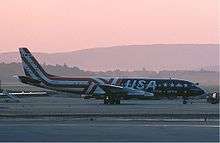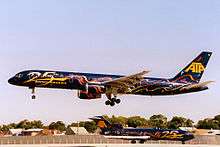Aircraft livery

An aircraft livery is a paint scheme applied to an aircraft, generally to fuselage, wings, empennage (tail fin), or jet engines. To promote their brands, airlines typically use a standard livery, prominently displaying their logo or name, that is applied to all or most of their fleet. Special liveries are used in certain circumstances, such as significant anniversaries for an airline or as part of a marketing agreement. Government and military aircraft also have liveries. The term is derived from the more general term “livery.”
Painting in multiple layers has changed for the application of a basecoat-clearcoat system, improving gloss and color retention, having a longer service life, lower weight and being quicker drying.[1]
Airline liveries
Standard airline liveries
Bare metal
Bare metal aircraft liveries are somewhat synonymous with the advances to aircraft technology during the 1930s and the tremendous sales success of the Douglas DC-3. What has often been called one of the first modern airliners which could actually turn a meaningful profit for airlines, the Douglas DC-3's sleek and shiny aluminum fuselage wings and body represented the latest in streamlining aircraft for increased speeds; this came at a time when many aircraft were still fabricated out of wood and canvas. Correspondingly, companies like Eastern Air Lines, Delta Air Lines, and American Airlines (now very well known for its distinctive bare-metal liveries) chose to leave their aircraft unpainted as a clear sign they operated the speediest and most up to date fleets. During more recent times, others, such as Air Canada, US Airways, Western Airlines, Pan Am, Aeromexico, Jat Airways, Northwest Airlines, and Cathay Pacific, also maintained unpainted airplanes during significant portions of their histories.
Among some advantages of not painting aircraft surfaces, this type of paint scheme reduces weight and therefore results in fuel savings; however, some analysts estimate that the extra cost to maintain and polish a bare metal scheme outweighs the fuel saving benefits.[2]
Cheatline

A cheatline is a decorative, horizontal, single or multiple, band of color or colors applied to the sides of a fuselage. Historically, the cheatline was located at or just below an aircraft's window line. However, in more recent times it has migrated and increasingly has become less laterally based.
Billboard
With the introduction of wide-body aircraft, a new form of livery also came about called the billboard livery. With billboard liveries the name of the airline became the unique and main feature of an airline's livery. By abandoning the cheatline that had traditionally run the length of the aircraft along the window-line; billboard liveries extend the name of the airline above and below the window-line in a much larger script. Early adopters of this style of airline livery were Union de Transports Aériens (UTA), Pan Am and AVENSA. Hughes Airwest adopted a billboard livery after the Flight 706 disaster. Other examples include Braniff with their 747SPs, Muse Air along their McDonnell Douglas aircraft, and Frontier Airlines along their Airbus aircraft. In recent years, two of the three main airline alliances have uniquely adopted billboard titling for their advertising branding and joint airline liveries.
Jelly bean

These liveries are characterized by the vertical stabilizer, and sometimes aft fuselage, being painted in multiple designs.
The most notable jelly bean livery used among North American airlines is the design concept introduced by Braniff International Airlines in November 1965, as part of their "End of the Plain Plane" campaign: there were 7 different, solid-colored schemes featuring pastel colors on the fuselage, white wings and tail, and formal black titles and nose.
A slight variant of the jelly bean concept is the "jelly tails" of JetBlue Airways, Mexicana, Frontier Airlines, and Air-India Express. British Airways’ short lived Newell and Sorrell World Tails design featured jelly bean liveries. PLUNA of Uruguay is one of the most recent airlines to adopt it.
Specialized airline liveries
Commemorative


Commemorative liveries are used to celebrate a milestone in an airline’s history, including anniversaries.
One such example would be ATA Airlines 25th anniversary paint scheme, celebrating the airline's inception under George Mikelson, the founder of American Trans Air, or SkyWest Airlines paint scheme used to commemorate the 30th anniversary of that airline.
South African Airways had one of their Boeing 747-300s specially painted in rainbow colors to transport the South African Olympic team to the 2000 Summer Olympics in Sydney, Australia. The aircraft was fondly dubbed the Ndizani.
Heritage Livery/Retrojet

A heritage livery is a livery that an airline has used in the past (apart from any modern livery used by an airline). Some airlines use these as a one off paint scheme applied to only one or two aircraft in their current fleet, as a tribute to their past. Airlines, the media, and enthusiasts call an aircraft painted in a heritage livery a retrojet.[3]
Logo
Airlines often apply and paint specialized liveries to their standard airline liveries and logos of their aircraft, examples being:
- a logo when used for charter service; sports teams and touring rock bands are common examples
- a logo of a prominent charity, when the airline and charity have a partnership
- images of a city, usually a hub or other city of importance to the airline
- advertising for a company (logojet)
Southwest Airlines is famous for its various liveries promoting Sea World (painted to resemble an Orca), various US states where Southwest has operations (painted to resemble the states' flags), and other entities such as the NBA and the Ronald McDonald House.
Marketing
All Nippon Airways has featured a number of aircraft in a promotional Pokémon livery, known as the Pokémon Jet. EVA Air partnered with Sanrio to create a number of "Hello Kitty Jets."
Other Air marketing liveries
Alliance brands


Three multinational worldwide airline alliances have grown and developed their own aircraft liveries and corporate identities which encompass and transcend major carriers, mainline carriers, legacy carriers, and flag airlines' individual airline identities along with any ties to regional, geopolitical, national boundaries, and government heritages.
Oneworld, SkyTeam, and Star Alliance are the mutually agreed upon "airline alliance liveries" of large numbers of independent and separately owned airlines working together as one through a system of codeshare agreements, rather than the colors of any one certificated airline.
Unlike the other airline alliance consortium members, Oneworld will retain the "jellytail" airline logo markings of their individual airline alliance partner members upon each member airline's vertical stabilizer.
Regional brands
Similar in terms of how multiple different airlines fly aircraft in full branding of standard OneWorld, SkyTeam, and Star Alliance liveries, in the United States along with many other parts of the world, large airlines often operate in association with other airlines which operate much smaller regional airliners so smaller communities are linked to an airlines large airline hub.
_American_Connection_(Chautauqua_Airlines)_N299SK_(7295779272).jpg)
To promote and offer air travelers with what appears as a "seamless" association with a much larger more prominent, well known, and publicly perceived as "more safe" major, mainline, legacy, discount, or flag carrier, airline; North American airlines have developed a system of affiliate air carriers.
These feeder airlines operate regional jets and other types of smaller utility air-taxi type aircraft, typically painted in ways that mimic (whether through distinctive fonts, colour combinations, or cheatline arrangements) the respective liveries of the operators with which they are affiliated. They may carry sub-branding such as Airlink, Connection, Eagle, or Express juxtaposed with the more widely-recognised carrier name.
A recent trend, in North America is for the regional airline d/b/a Express, Eagle, or Connection, is to operate the aircraft in full mainline airline markings, leaving the operating regional airlines name in only very small letters, close to the forward entry door. Such brandings noted to cause confusion among travelers, as in the case of Colgan Air Continental Express flight disaster, often stimulate added confusion when operations do not go as planned due to inclement weather and other natural disturbances, and the ensuing fee changes during rebooking, or other ticketing.
Non airline liveries
Government
.jpg)
Air transports of heads of state and government are often painted in unique color schemes. The US President's aircraft, Air Force One, uses a light-blue and sky-blue color scheme, with the Seal of the President of the United States just above the front gear and the flag of the United States on the tailfin designed by French-American industrial designer Raymond Loewy.[4]
An aircraft used to transport state or government leaders is often painted in a livery that represents national colors of a country or colors of a particular government office, and most of the time is coordinated with a flag, seal, and other insignia.
Military
Military aircraft often make use of aircraft camouflage to make the aircraft more difficult to see in the air and on the ground. This form of camouflage makes use of light and color patterns, and is dependent upon environmental conditions and is mainly effective against human observers, though some electronic visual acquisition systems can be affected. Visual camouflage does not protect an aircraft against radar location or heat-seeking electronics.
Since the release of MIL-STD-2161 in 1993, the US Navy's tactical aircraft use a color scheme designed to reduce visual detection that consists of shades of flat gray with exterior markings applied in a contrasting shade of gray.[5] Note that the stated purpose of this document is to standardize paint schemes and application of naval insignia and markings.
Aircraft camouflage was first used during World War I and was employed extensively during the first half of World War II. After radar detection systems were developed, aircraft camouflage became less important to the Allies, and a number of late-war Allied aircraft were brought to battle with no camouflage. Subsequent camouflage schemes, when used, concentrated on hiding the aircraft from aerial observation while it was resting on or flying near the ground, or they used a light, neutral color to inhibit detection while in the air. Modern camouflage schemes have experimented with light-emitting active camouflage systems which seek to conceal the aircraft from human vision or to blur or confuse optical observation by electronic means.[6]
See also
| Wikimedia Commons has media related to Aircraft liveries. |
References
- ↑ "Solving The Elusive Element To Paint Advancement". Inside MRO. Aviation Week. Aug 11, 2016.
- ↑ "Painting versus Polishing of Airplane Exterior Surfaces". Aero Magazine. Boeing. January 1999.
- ↑ "Happy 85th: LOT adds 'RetroJET' livery to Embraer E175". USA Today. Retrieved 18 June 2015.
- ↑ Walsh, Kenneth T. Air Force One: A History of the Presidents and Their Planes. New York: Hyperion: 2003. ISBN 1-4013-0004-9.
- ↑ "MIL-STD-2161A, Department of Defense Standard Practice: Paint Schemes and Markings for U.S. Navy and Marine Corp Aircraft" (PDF). United States Navy. 1 May 1993.
- ↑ Shaw, Robert (1985). Fighter combat: tactics and maneuvering. Naval Institute Press. p. 55. ISBN 0-87021-059-9.


